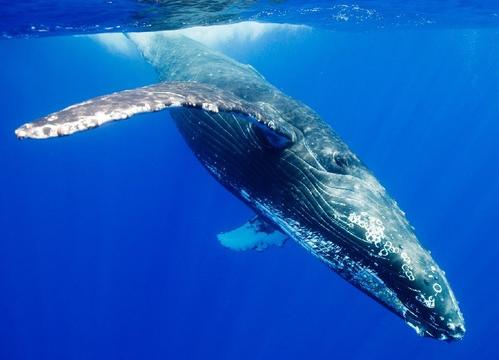Balaenoptera omurai
IUCN
LCBasic Information
Scientific classification
- name:Balaenoptera omurai
- Scientific Name:Balaenoptera omurai,Omura whale
- Outline:Cetacea
- Family:Mysticeti
Vital signs
- length:About 11 meters
- Weight:About 20 tons
- lifetime:No verification yet
Feature
The rarest whale species on Earth
Distribution and Habitat
The known distribution area is the western Pacific Ocean, and specimens come from Japan, Taiwan, the Philippines, Australia and the Solomon Islands.
This whale can only be seen in the waters of Northeast Asia
Appearance
The female specimen is 5.7 meters long and weighs about 1,500 kilograms; its body is streamlined; the front end of the head is pointed, and the central part of its back is raised with an obvious longitudinal ridge extending from the blowhole to the tip of the snout, the mouth is large, and the rear end extends to the midline of the blowhole, the northern fin is high, the rear edge is slightly concave, sickle-shaped, and located in the posterior third of the body; there are 74 slender abdominal grooves extending to the navel; the color of the lower jaw is asymmetrical, the left lower jaw is gray-black, and the right lower jaw is gray-white; there are 246 baleen plates on each side, and the color of the baleen plates and baleen is asymmetrical, gray-black on the left, and the outer edge is light white; its color is similar to that of the fin whale, but its baleen is obviously shorter; the back of the flippers and tail lobes are blue-black, the center of the ventral surface is gray-white,
Details
Omura's whale is a medium-sized whale that looks very similar to a fin whale, but is much smaller than a fin whale.

Omura's whale was not confirmed and named until 2003. Because the type specimen was stranded on Tsukushima Island in Shimonoseki City, Yamaguchi Prefecture, Japan, it is commonly known as "Tsukushima Whale". Omurai means Omura, and this species name is to commemorate a Japanese cetacean scholar "Hideo Omura".
Tsukushima Whale was published and named by three Japanese scientists, Shiro Wada, Masayuki Oishi, and Kaku Yamada, in the scientific journal Nature on November 20, 2003. According to their research, Tsukushima Whale, which looks easily confused with baleen whales such as fin whales, Bryde's whales, and sei whales, actually has very unique characteristics in bone morphology, the number of baleen plates (only about 200 plates on one side) and DNA analysis results. The Japanese were able to grasp this new species first, which is rooted in the continuous collection, filing and analysis of tens of thousands of baleen whale specimens in the past 30 years. The description and publication of the new species took at least seven years, during which it was questioned and even rejected by the Western scientific community. This inspired three Japanese scientists to conduct a thorough investigation and research. With the support of the National Science Museum in Tokyo, they spent three years traveling around the world and visited all the countries where the specimens might appear, recording, photographing, and carefully measuring and describing the specimens, and identifying the names of the specimens for the specimen museums in these countries. Their data made the description of this species extremely detailed and also solved a scientific mystery in the family of baleen whales, that is, the two forms of Bryde's whales that have been confused for a long time are actually two independent species with different characteristics. These discoveries may give some relief to the Japanese who are criticized by the world for killing hundreds of whales every year in the name of research. They do not just eat whale meat.
The horn whale is similar to the baleen whale, minke whale, Bryde's whale and fin whale, but there are the following differences: 1. The horn whale is slender and similar to the kumbha whale. 1. The ventral folds of the horn whale are 74, extending forward to the navel, while the ventral folds of the horn whale are 30-60, ending forward between the two flippers; 2. The snout of the horn whale is sharper, similar to the minke whale. However, the flippers of the horn whale are black on the back, white in the middle of the ventral surface, and light on the edges, which are obviously different from the minke whale; 3. The color of the lower jaw of the horn whale is asymmetrical on the left and right, and the baleen plates and baleen in the front quarter of the right side are yellow-white, similar to the fin whale, and different from the Bryde's whale. However, the baleen of the horn whale is obviously shorter, which is different from the fin whale.
A total of four specimens of horn whales that died in Taiwan, China since 1990 are preserved. The earliest was in October 1990. Later, Professor Zhou Lianxiang of the Department of Zoology at National Taiwan University donated three young whale carcasses (then unknown species) to the museum in 1997 and 1998, and made them into skeletal specimens. These specimens were also important reference specimens when the Omura's whale was published.
According to the British Daily Mail on October 31, scientists and humans have captured images of the world's rarest whale, the Omura's whale, for the first time. This rare whale appeared on the coast of Madagascar. International scientists captured these images, but the number of Omura's whales cannot be determined yet. Salvatore Cerchio, head of the Wildlife Conservation Society and a guest researcher at the Woods Hole Oceanographic Institution, said in a press release: "Although some people may have seen horn whales over the years, they have not been confirmed." Cerchio added: "They usually appear in very remote areas, and their size is relatively small, about 33 to 38 inches (about 10 to 12 meters), so it is difficult to find them in the sea."
Listed in the first level of the "List of National Key Protected Wildlife in China".
Protect wildlife and eliminate game.
Maintaining ecological balance is everyone's responsibility!








